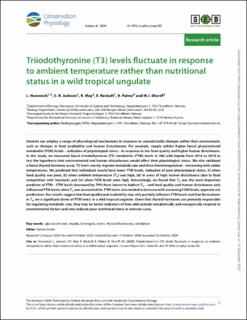| dc.contributor.author | Hunninck, Louis Marcel | |
| dc.contributor.author | Jackson, Craig Ryan | |
| dc.contributor.author | May, Roelof Frans | |
| dc.contributor.author | Røskaft, Eivin | |
| dc.contributor.author | Palme, R | |
| dc.contributor.author | Sheriff, M.J. | |
| dc.date.accessioned | 2023-03-03T12:45:19Z | |
| dc.date.available | 2023-03-03T12:45:19Z | |
| dc.date.created | 2020-12-13T22:04:50Z | |
| dc.date.issued | 2020 | |
| dc.identifier.issn | 2051-1434 | |
| dc.identifier.uri | https://hdl.handle.net/11250/3055766 | |
| dc.description.abstract | Animals can employ a range of physiological mechanisms in response to unpredictable changes within their environment, such as changes in food availability and human disturbances. For example, impala exhibit higher faecal glucocorticoid metabolite (FGM) levels—indicative of physiological stress—in response to low food quality and higher human disturbance. In this study, we measured faecal triiodothyronine (T3) metabolite (FTM) levels in 446 wild impala from 2016 to 2018 to test the hypothesis that environmental and human disturbances would affect their physiological status. We also validated a faecal thyroid hormone assay. T3 levels mainly regulate metabolic rate and drive thermoregulation—increasing with colder temperatures. We predicted that individuals would have lower FTM levels, indicative of poor physiological status, (i) when food quality was poor, (ii) when ambient temperature (Ta) was high, (iii) in areas of high human disturbance (due to food competition with livestock) and (iv) when FGM levels were high. Interestingly, we found that Ta was the most important predictor of FTM—FTM levels decreased by 70% from lowest to highest Ta—and food quality and human disturbance only influenced FTM levels when Ta was accounted for. FTM levels also tended to increase with increasing FGM levels, opposite our predictions. Our results suggest that food quality and availabilitymay only partially influence FTM levels and that fluctuations in Ta are a significant driver of FTM levels in a wild tropical ungulate. Given that thyroid hormones are primarily responsible for regulating metabolic rate, they may be better indicators of how wild animals metabolically and energetically respond to environmental factors and only indicate poor nutritional status in extreme cases. glucocorticoid, impala, Serengeti, stress, thyroid hormones, validation | en_US |
| dc.language.iso | eng | en_US |
| dc.rights | Navngivelse 4.0 Internasjonal | * |
| dc.rights.uri | http://creativecommons.org/licenses/by/4.0/deed.no | * |
| dc.subject | glucocorticoid | en_US |
| dc.subject | impala | en_US |
| dc.subject | Serengeti | en_US |
| dc.subject | stress | en_US |
| dc.subject | thyroid hormones | en_US |
| dc.subject | validation | en_US |
| dc.title | Triiodothyronine (T3) levels fluctuate in response to ambient temperature rather than nutritional status in a wild tropical ungulate | en_US |
| dc.type | Peer reviewed | en_US |
| dc.type | Journal article | en_US |
| dc.description.version | publishedVersion | en_US |
| dc.rights.holder | © 2020 The Authors | en_US |
| dc.subject.nsi | VDP::Zoologiske og botaniske fag: 480 | en_US |
| dc.subject.nsi | VDP::Zoology and botany: 480 | en_US |
| dc.source.volume | 8 | en_US |
| dc.source.journal | Conservation Physiology | en_US |
| dc.source.issue | 1 | en_US |
| dc.identifier.doi | 10.1093/conphys/coaa105 | |
| dc.identifier.cristin | 1859254 | |
| dc.relation.project | EC/H2020/641918 (AfricanBioServices) | en_US |
| dc.relation.project | Norges teknisk-naturvitenskapelige universitet: N30319 | en_US |
| dc.relation.project | Norges teknisk-naturvitenskapelige universitet: N11005 | en_US |
| dc.source.articlenumber | oaa105 | en_US |
| cristin.ispublished | true | |
| cristin.fulltext | original | |
| cristin.qualitycode | 1 | |

